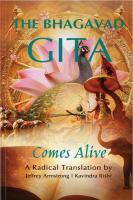You are only seeing posts authors requested be public.
Register and Login to participate in discussions with colleagues.
The Bhagavad Gita Comes Alive
Public
 Dr Chris Sedegreen.
Dr Chris Sedegreen.
Some time before the Christmas holiday a colleague mentioned a book, The Bhagavad Gita Comes Alive, on the Doclounge listserve. I’d like to thank him for bringing this lovely book to our attention. I ordered and received the paperback version (somewhat cheaper than the hard cover, but in retrospect I wish I'd ordered the hard cover). This publication is beautifully printed.
The translation has been most thoughtfully produced. In any language there are words and phrases that simply cannot be directly translated from one language to another, and where this is the case the translator has left the original Sanskrit in place and provided a glossary where a single word may require a whole paragraph of explanation. This is exactly as it should be. I've only got as far as 'chapter 3 - verse 130 so far but have savoured every word along the way. But this isn’t a book you will read once and then put on the shelf to gather dust. Each verse compresses a wealth of wisdom for further reflection and study. It’s the kind of book you will want to come back to and read parts, perhaps at random, again and again.
It can also be likened to the ancient Sanskrit text, the Upanishads, which still serves as a basis for Hindu spirituality.
Among the several commentators writing in the forewords is our highly esteemed colleague (and former BCMA President) Dr. Arun Garg, Ph.D. MD. also Founding Chair of the Canada India Network Society.
The translator is one Jeffrey Armstrong, a.k.a. Kavindra Rishi, who spent a decade in the effort to render a faithful expression of the original meaning. (Previous translations, while probably well intentioned, suffered from the preconceptions and prejudices of colonial occupiers of India; and so failed to render a faithful interpretation).
At the very great risk of over-simplifying, the Bhagavad Gita is an 'imaginary' conversation between a warrior prince and a (the?) 'deity' that took place before a mighty battle roughly 7,000 years ago. Forming but a part of a much larger work, the Mahabharata, it is a discussion about personal ethics and morality and the manner in which one should seek to live one's life in the pursuit of enlightenment and immortality of one's 'atman' (which means, very approximately, one's soul or true essence or inner self). As such it is also aligned quite closely to the modern branch of psychology known as or dealing with 'Mindfulness'.
This is not esoteric or 'difficult' to read. Neither is it ‘preachy’ even though it deals with matters of spiritual growth. Yet at the same time, the reader cannot fail to be impressed with the wisdom it expresses.
Perhaps at no time more than the present, when we witness what is happening in the world around us, this ancient wisdom should inform our current thought.
https://www.amazon.ca/Bhagavad-Gita-Comes-Alive-Translation-ebook/dp/B08...





Thank youPublic
Here is a video interview with the author, Jeffrey ArmstrongPublic
This video where the host and Dr Arun Garg interview the author, Jeffrey Armstrong, was live streamed and recorded on January 12, 2021. It is almost an hour long and is interesting as Dr Arun Garg uses the opportunity to explore and delve into details of the Bhagavad Gita with Jeffrey Armstrong who spent 10 years working on translating the book from Sanskrit to English.
Jeffrey Armstrong interview video link
There is a lot to learn through this interview including that the Bhagavad Gita highlights, "We are what we eat" and in a sense "We are eating the emotions, the states of mind and attitudes we carry with us. ... Our thoughts are a kind of food ... that can destroy ourselves, sustain ourselves or bring ourselves to optimum health, well being and higher states". It embraces a holistic approach including the foods we eat, the emotions, thoughts and attitudes we have, and the activities we engage in. It also emphasizes aligning ourselves with nature and lessons for leadership. And while charity may be misunderstood to be condescending its true meaning is to recirculate resources for the benefit of all.
Dr. Arun Garg summarizes, on a practical note, "This book is a tool for success, a recipe for living a healthy life. Written in a very simple language, a true translation, not a colonial translation".